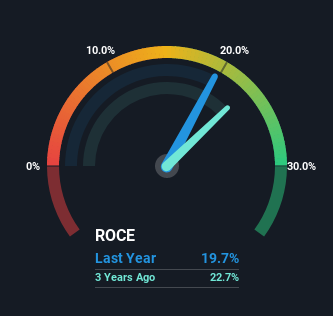Finding a business that has the potential to grow substantially is not easy, but it is possible if we look at a few key financial metrics. Typically, we'll want to notice a trend of growing return on capital employed (ROCE) and alongside that, an expanding base of capital employed. Basically this means that a company has profitable initiatives that it can continue to reinvest in, which is a trait of a compounding machine. Looking at Advanced Petrochemical (TADAWUL:2330), it does have a high ROCE right now, but lets see how returns are trending.
What is Return On Capital Employed (ROCE)?
If you haven't worked with ROCE before, it measures the 'return' (pre-tax profit) a company generates from capital employed in its business. The formula for this calculation on Advanced Petrochemical is:
Return on Capital Employed = Earnings Before Interest and Tax (EBIT) ÷ (Total Assets - Current Liabilities)
0.20 = ر.س883m ÷ (ر.س6.2b - ر.س1.7b) (Based on the trailing twelve months to March 2022).
Therefore, Advanced Petrochemical has an ROCE of 20%. In absolute terms that's a great return and it's even better than the Chemicals industry average of 9.2%.
See our latest analysis for Advanced Petrochemical

Above you can see how the current ROCE for Advanced Petrochemical compares to its prior returns on capital, but there's only so much you can tell from the past. If you'd like to see what analysts are forecasting going forward, you should check out our free report for Advanced Petrochemical.
What The Trend Of ROCE Can Tell Us
Things have been pretty stable at Advanced Petrochemical, with its capital employed and returns on that capital staying somewhat the same for the last five years. Businesses with these traits tend to be mature and steady operations because they're past the growth phase. So it may not be a multi-bagger in the making, but given the decent 20% return on capital, it'd be difficult to find fault with the business's current operations. On top of that you'll notice that Advanced Petrochemical has been paying out a large portion (94%) of earnings in the form of dividends to shareholders. Most shareholders probably know this and own the stock for its dividend.
On another note, while the change in ROCE trend might not scream for attention, it's interesting that the current liabilities have actually gone up over the last five years. This is intriguing because if current liabilities hadn't increased to 28% of total assets, this reported ROCE would probably be less than20% because total capital employed would be higher.The 20% ROCE could be even lower if current liabilities weren't 28% of total assets, because the the formula would show a larger base of total capital employed. With that in mind, just be wary if this ratio increases in the future, because if it gets particularly high, this brings with it some new elements of risk.
What We Can Learn From Advanced Petrochemical's ROCE
Although is allocating it's capital efficiently to generate impressive returns, it isn't compounding its base of capital, which is what we'd see from a multi-bagger. Yet to long term shareholders the stock has gifted them an incredible 135% return in the last five years, so the market appears to be rosy about its future. But if the trajectory of these underlying trends continue, we think the likelihood of it being a multi-bagger from here isn't high.
One final note, you should learn about the 3 warning signs we've spotted with Advanced Petrochemical (including 2 which can't be ignored) .
If you'd like to see other companies earning high returns, check out our free list of companies earning high returns with solid balance sheets here.
New: Manage All Your Stock Portfolios in One Place
We've created the ultimate portfolio companion for stock investors, and it's free.
• Connect an unlimited number of Portfolios and see your total in one currency
• Be alerted to new Warning Signs or Risks via email or mobile
• Track the Fair Value of your stocks
Have feedback on this article? Concerned about the content? Get in touch with us directly. Alternatively, email editorial-team (at) simplywallst.com.
This article by Simply Wall St is general in nature. We provide commentary based on historical data and analyst forecasts only using an unbiased methodology and our articles are not intended to be financial advice. It does not constitute a recommendation to buy or sell any stock, and does not take account of your objectives, or your financial situation. We aim to bring you long-term focused analysis driven by fundamental data. Note that our analysis may not factor in the latest price-sensitive company announcements or qualitative material. Simply Wall St has no position in any stocks mentioned.
About SASE:2330
Advanced Petrochemical
Engages in the production and sale of propylene, polypropylene, isopropyl alcohol, polysilicon, and polysilicon downstream products in the Kingdom of Saudi Arabia and internationally.
High growth potential average dividend payer.
Market Insights
Community Narratives



